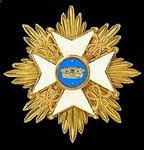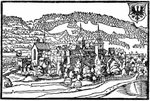Here's something a bit different; the flags of a legion of light infantry and cavalry in the French army, no doubt carried only by the fusilier companies (unless someone knows otherwise!).
From Pajol, Les Guerres Sous Louis XV Volume 7, Paris 1891 [My translation]:
Volontaires Royaux first raised 15th August 1745 from former free companies of infantry and dragoons with the exception of those of Fischer and Goengoesy. They counted at their creation 12 companies, 100 dragoons and a company of hussars.
On the 19th November 1756 they were increased to 2,150 men of whom 900 were dragoons. On the 7th May 1758 on account of their valour and services they were given the title of Légion Royale.
Légion Royale: Formed the 7th May 1758 with 17 companies, of which 2 were grenadiers, 12 of fusiliers, of dragoons, of hussars and 60 workmen [ouvriers = pioneers?], they were also equipped with 2 light artillery pieces à la Suedoise [4 pounders]. In consideration of the fact that it was the oldest of all the light troops and also because of its composition and its recognized utility, it was augmented by the remains of the volunteers of Hainaut made prisoner at Minden. On the 11th November 1758 it was increased to 2.700 men plus a new company of hussars.
The 10th February 1759: "The services which the Légion Royale has rendered, since its creation and particularly in the latest campaigns, the need of light troops in the current wars, either in relation to the different countries that it is so important to know well, or by the need to have troops always in front, to know the movements of enemies, demonstrates the importance of increasing the numbers of these troops - The King"
On the 17th May 1763 the Legion was increased by 8 companies of fusiliers and 8 companies of dragoons.
Service: 1745 in Flanders; 1747 with the Army of the Alps, County of Nice and in the Var, up to the peace; 1757 the advance guard of the Army of Germany; 1758 battles of Rittberg, Hastenbeck and Clostercamps; 1763 Huningue [and more beyond the SYW which I have not listed].
The Legion was reformed in 1776.
Uniforms: Hussars: Blue dolman and pelisse with black braiding and white buttons; red pouch; breeches and shabraque blue.
1759-1767: Fusiliers: waistcoat and coat blue with collar; facings red; breeches white; tricorne laced white.
Dragoons: blue coat; collar, cuffs and turnbacks red; waistcoat and breeches white; shabraque blue with white lace, edged red.
------------------------------------------
Much more on the history of this unit in the Seven Years War and before can be found on Kronoskaf.
Here's the fusilier uniform in 1756:





















